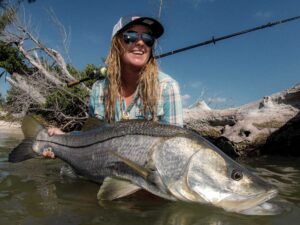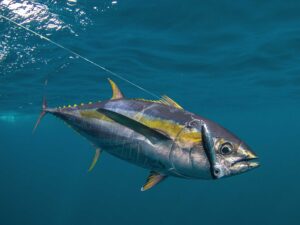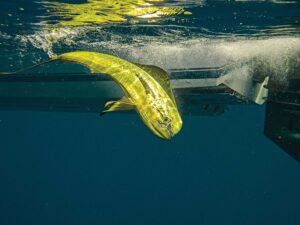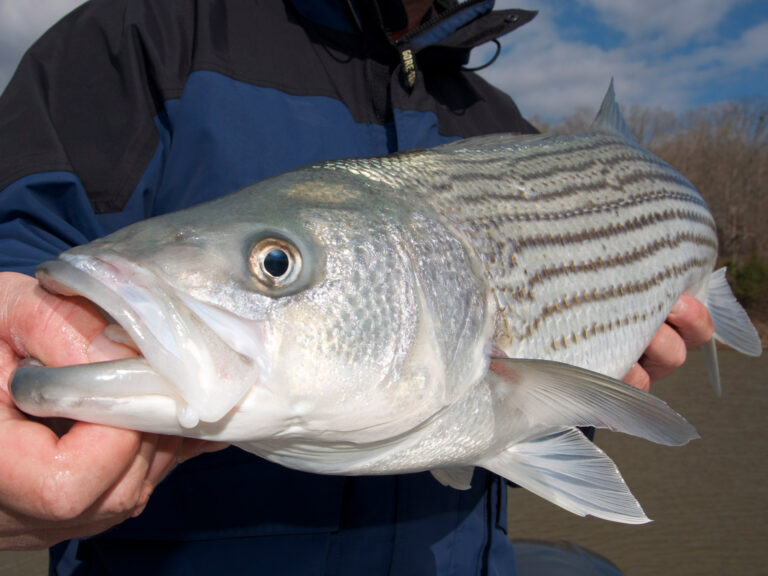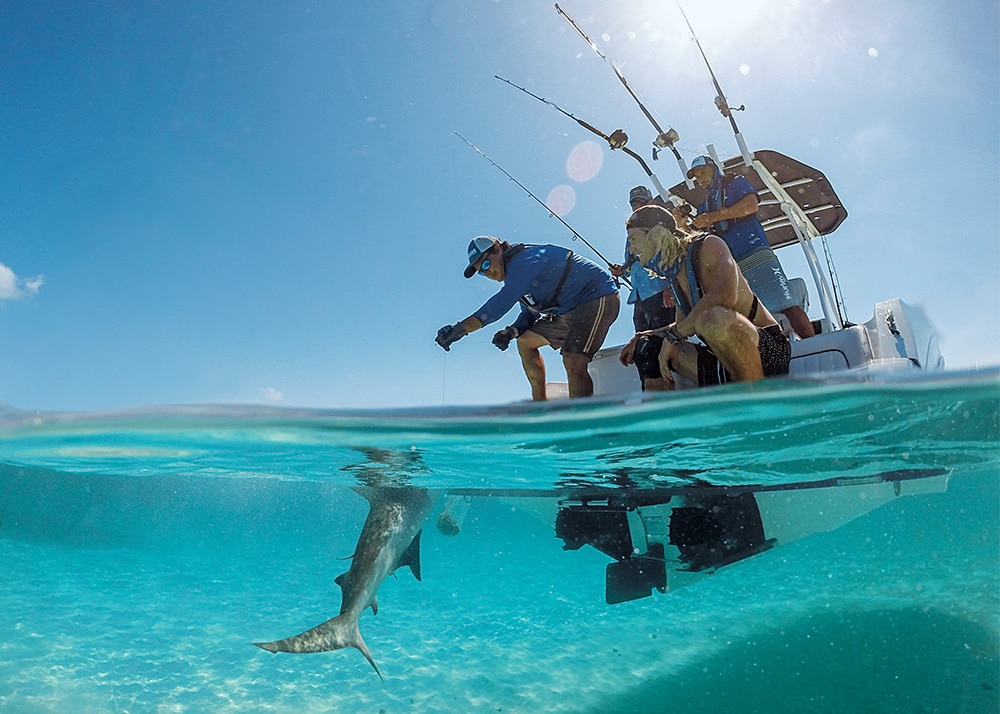
Minutes after dropping anchor and setting out a chum bag, assorted reef fish began congregating behind the boat. Ballyhoo soon showed up also, and Capt. Danny Hampson quickly put a dozen in the livewell with his cast net. Knowing big snapper and grouper love ballyhoo, I sent one to the bottom on a sliding-sinker rig and braced for the inevitable — a Berry Islands bruiser would surely chomp on my bait at any moment.
With daylight fading, the clear, calm water that minutes earlier divulged every nuance of the bottom some 40 feet below became an increasingly opaque veil. Bottom dwellers were bound to go on the hunt soon.
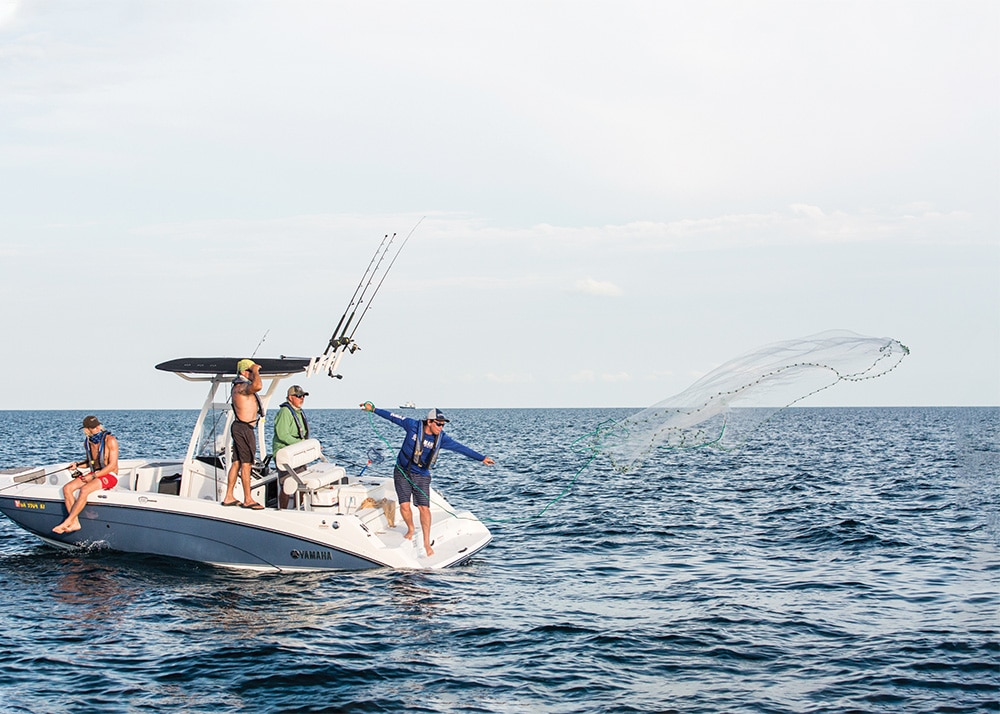
Magic Hour Before the sun completely tucked behind the horizon, something attacked my bait. I set the hook and felt the power of a brawny bottomfish doing its best to reach the nearest rocky lair. But the 30-pound braid and 40-pound fluoro leader survived the fish’s escape attempts, and a 12-pound mutton snapper went into the fish box.
That first fish got the crew excited, and everyone focused on adding to the catch and our dinner options. Luckily, the bite turned on. Shortly, every bait was mauled right after reaching bottom. Some of the culprits broke off on jagged structure, yet we eventually headed to the dock with several more big muttons, a couple of grouper and a few nice yellowtail on ice.
The Mission That was the first night of our Berry Islands fishing expedition, an endurance test of sorts, which began and ended in Miami, and required crossing both the Gulf Stream and Great Bahama Bank en route to the Berry Islands’ Great Harbour Cay. The purpose of this 290-mile round trip — with lots of fishing mixed in — was to put Yamaha Watercraft’s new 210 FSH through its paces in a variety of situations, and experience all that the versatile 21-foot jet-powered center-console has to offer the avid angler.
Andrew Cullen from Yamaha Watercraft enlisted seasoned Florida Keys captains Tim and Danny Hampson to lead our crew, which also included Bob Gonsalves from ICBM Media, social media influencer Rory Kramer, professional videographers/photographers Collin Harrington and Zach Stovall, and yours truly.
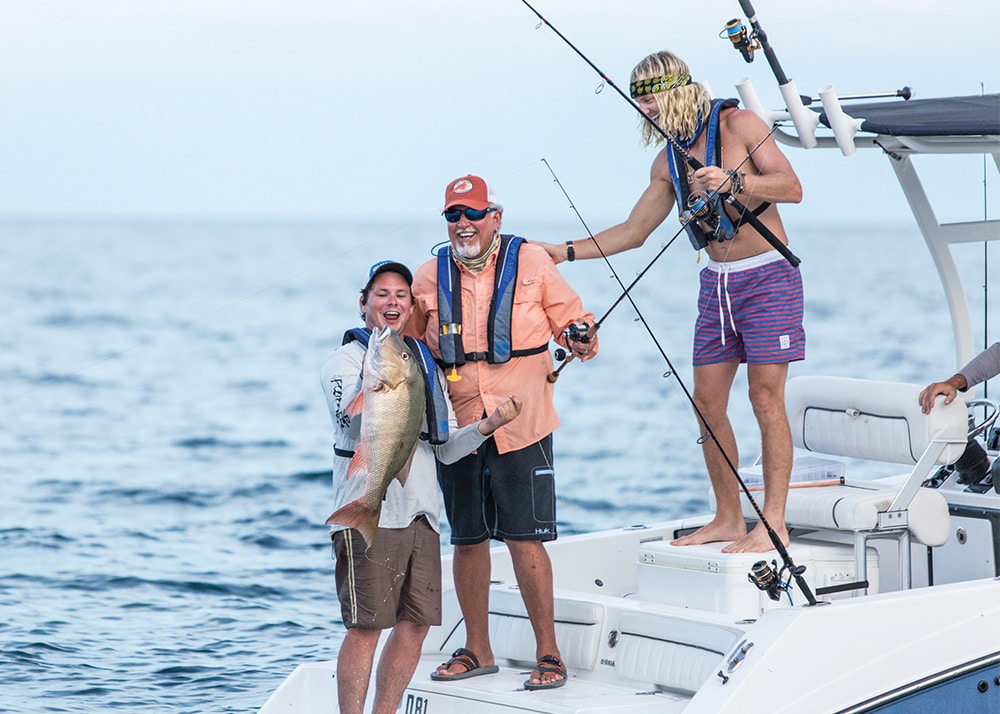
Dolphin Interlude We celebrated landfall after a comfortable and uneventful trip across the Gulf Stream with conch fritters and a cold Kalik while waiting for a Bahamas Customs and Immigration officer at the Bimini Big Game Club. Once cleared, we headed back out to investigate some of the water we’d just traversed, before continuing east. Just southwest of Bimini, we came upon a large floating log that demanded closer inspection. Armed with spinning and casting outfits, we let jigs and ballyhoo baits rain down around the log, and were promptly rewarded with several hookups on acrobatic grasshopper dolphin. While the action was short-lived, it was a nice wind-down after the first leg of the crossing.
Bank Withdrawal With clear skies and a gentle breeze in the forecast for the remaining 85 miles to the Berry Islands, Capt. Tim Hampson aboard his Contender Reef Freak led the way to a little-known shallow wreck on the Great Bahama Bank, about halfway to our destination.
No chum was deployed, since the stop was meant only as a second intermission. We simply drifted unweighted baits past the wreck, in 10 feet of water, and had a blast yanking on plump yellowtail and mangrove snapper. We also boated, a couple of red grouper, a pretty Nassau and four tough-fighting muttons to 8 pounds before resuming our trek to Great Harbour Cay.
Bluewater Bust The ocean was snotty the next morning, but determined to see how the 210 FSH handled such conditions, we stuck with our plan to search for pelagics along the steep drop in the bank, off the north end of the island.
Taking the helm for several hours, I was pleasantly surprised at the seaworthiness of the 21-footer, which took on 4-foot waves with ease. Driving a boat with twin jet drives instead of a single outboard — the more common propulsion for a center-console this size — felt a little odd, but I soon got the hang of it and enjoyed both trolling around weed lines and racing toward birds we spotted dipping and fluttering enticingly, low to the water.
By lunchtime, with only bonito and barracuda to show for our efforts, and other crews reporting similar results on the radio, we decided to try for sharks on fly and light tackle inshore in the afternoon.
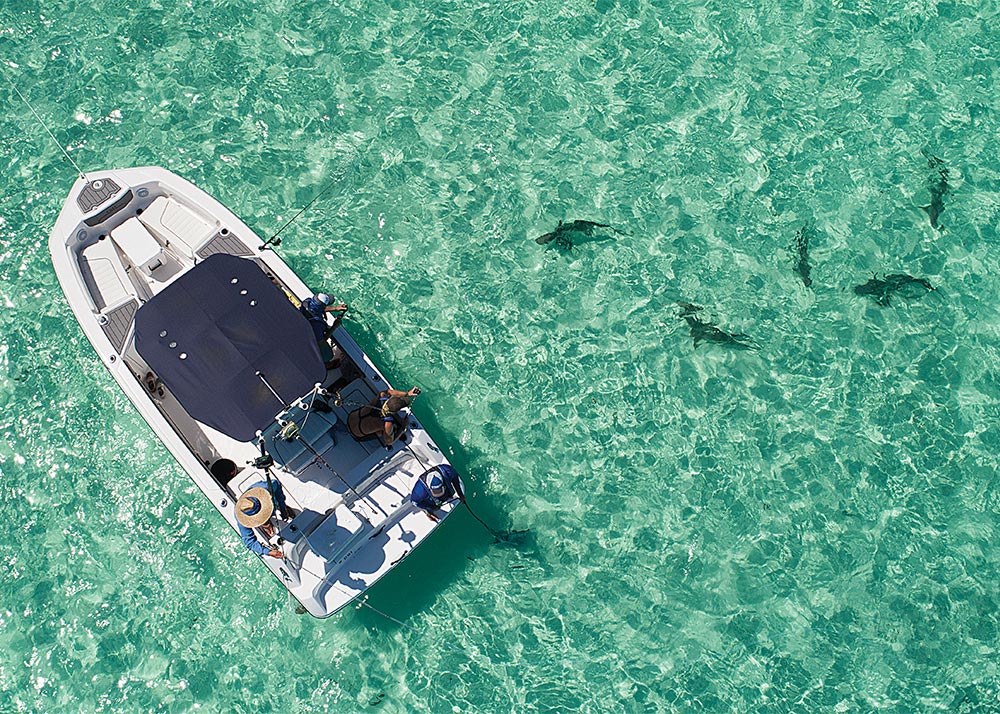
Fintastic Alternative Anchoring in a sheltered bay adjacent to open water, we chummed with the cudas we caught offshore and summoned several blacktip, lemon and sandbar sharks within minutes. The sandbars were bigger but more timid; however, the barracuda scent finally drew them within range, and I dropped a big red fly right in front of a 6-footer. The jet boat’s open rear (it sports a full-width swim platform with an aft-facing bench instead of the usual transom bulkhead) enabled me to stand at the water’s edge to pick my target and cast. The sandbar ate without hesitation, and was off to the races with my fly line in tow the instant I set the hook.
Drag pressure had the desired effect, and every subsequent run was shorter than the last. Soon Danny Hampson grabbed the leader, removed the hook, and bid the shark adieu. The commotion turned other marauding sharks more brazen, and Rory Kramer and Andrew Cullen got in on the action before we left for the patch reefs to catch our dinner.
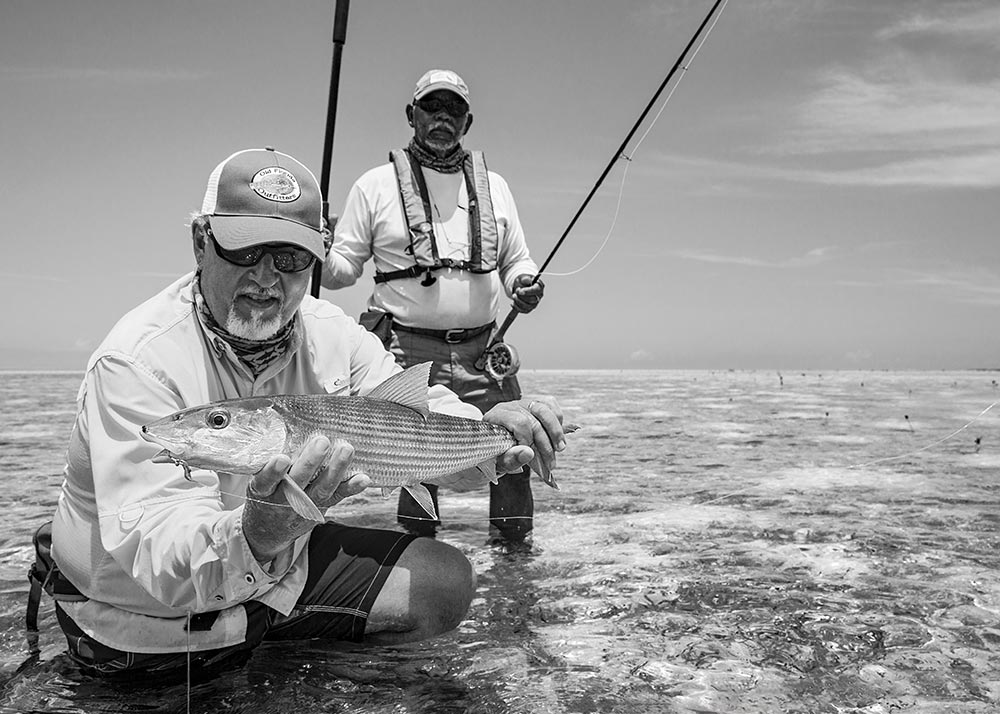
Bone-a-Fide Fun With world-class bonefishing a short run from Great Harbour, we agreed to spend our last day on the flats. Veteran local guide Percy Darville helped us navigate the maze of narrow, unmarked channels and skinny water, considerably less stressful aboard the jet boat, which lacks typical lower units, propellers and skegs below the waterline.
Upon setting down in a bowl bordered by expansive, wadeable flats, Darville and I went searching for bones on foot. It didn’t take us long to come across the first pack of tailers. Dropping to one knee, I lobbed a short cast in their path and coaxed the closest fish to slurp a shrimp pattern. In typical bonefish fashion, it bolted as soon as it felt the prick, and despite close encounters with a couple of mangrove shoots, the beautiful gray ghost posed for a quick photo before its release.
Read Next: Bonefish on the Flats, Andros Island, The Bahamas
We repeated the process four more times, but also missed some chances, including a huge fish estimated at 10 pounds that broke off as it zigzagged between mangroves to give a hungry barracuda the slip — just another reason to come back to the Berry Islands soon.
Boat Travel To The Bahamas The Berry Islands, a cluster of 30 mostly uninhabited cays, are part of the 700 islands and more than 2,000 cays and rocks that make up the Bahamas. Reaching them by boat is easy, as long as you pick a favorable weather window — more likely during summer and fall — and have the appropriate navigation and safety equipment. Be sure to carry the boat registration and valid passports for the entire crew, as well as a yellow quarantine flag to display from the time you enter Bahamian waters until you clear customs at the nearest port of entry. There’s a flat fee of $150 for boats 35 feet and under, and $300 for bigger craft. It covers the vessel with up to three people ($25 departure tax for each additional person), as well as the cruising and fishing permits. For complete travel regulations and requirements, visit cbp.gov and gooutdoorsbahamas.com.

